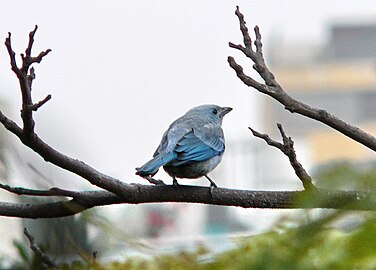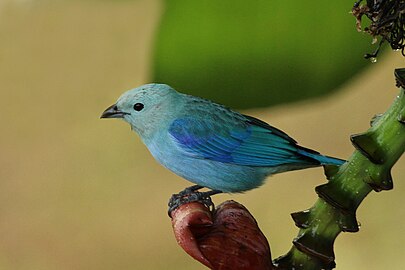Blue-gray tanager
| Blue-gray tanager | |
|---|---|

| |
| T. e. cana in Darién National Park (Panama) | |
| Scientific classification | |
| Domain: | Eukaryota |
| Kingdom: | Animalia |
| Phylum: | Chordata |
| Class: | Aves |
| Order: | Passeriformes |
| Family: | Thraupidae |
| Genus: | Thraupis |
| Species: | T. episcopus
|
| Binomial name | |
| Thraupis episcopus (Linnaeus, 1766)
| |

| |
| Synonyms | |
| |
The blue-gray tanager (Thraupis episcopus) is a medium-sized
Taxonomy
In 1760 the French zoologist
There are 14 recognized
Description
The blue-gray tanager is 16–18 cm (6.3–7.1 in) long and weighs 30–40 g (1.1–1.4 oz). Adults have a light bluish head and underparts, with darker blue upperparts and a shoulder patch colored a different hue of blue. The bill is short and quite thick. Sexes are similar, but the immature is much duller in plumage.
The song is a squeaky twittering, interspersed with tseee and tsuup call notes.
Breeding and habitat
The breeding habitat is open woodland, cultivated areas and gardens. The blue-gray tanager lives mainly on fruit, but will also take some nectar, insects and other arthropods.[9][10] This is a common, restless, noisy and confiding species, usually found in pairs, but sometimes small groups. It thrives around human habitation, and will take some cultivated fruit like papayas (Carica papaya).
One to three, usually two, dark-marked whitish to gray-green eggs are laid in a deep cup nest in a high tree fork or building crevice.
Two birds studied in the
Agricultural ecology
T. episcopus prospers in some areas cleared by humans
T. episcopus is commonly infected with Blastocystis parasites, specifically Subtype 6 (ST6) which was exclusive to birds in that area.[16] ST6 was never found in cows in the area, but it was unassessed whether T. episcopus shares ST6 with nearby domesticated bird flocks.[16]
Status
Widespread and common throughout its large range, the blue-gray tanager is evaluated as
Sub species
References
- ^ . Retrieved 24 November 2022.
- ^ a b Morlan, Joseph (2019-08-20). "Blue-gray Tanager (Thraupis episcopus caerulea)". City College of San Francisco FOG. Retrieved 2021-04-10.
- ^ Brisson, Mathurin Jacques (1760). Ornithologie, ou, Méthode contenant la division des oiseaux en ordres, sections, genres, especes & leurs variétés (in French and Latin). Vol. 3. Paris: Jean-Baptiste Bauche. pp. 40–41, Plate 1 fig 2. The two stars (**) at the start of the paragraph indicates that Brisson based his description on the examination of a specimen.
- ^ hdl:2246/678.
- ^ Linnaeus, Carl (1766). Systema naturae : per regna tria natura, secundum classes, ordines, genera, species, cum characteribus, differentiis, synonymis, locis (in Latin). Vol. 1, Part 1 (12th ed.). Holmiae (Stockholm): Laurentii Salvii. p. 316.
- ^ Jobling, J.A. (2018). del Hoyo, J.; Elliott, A.; Sargatal, J.; Christie, D.A.; de Juana, E. (eds.). "Key to Scientific Names in Ornithology". Handbook of the Birds of the World Alive. Lynx Edicions. Retrieved 2 April 2018.
- ^ Boie, Friedrich (1826). "Generalübersicht". Isis von Oken (in German). Col 974.
- ^ Gill, Frank; Donsker, David, eds. (2018). "Tanagers and allies". World Bird List Version 8.1. International Ornithologists' Union. Retrieved 2 April 2018.
- ^ a b "Blue-Gray Tanager Fact Sheet". Lincoln Park Zoo.
- ^ https://birdsoftheworld.org/bow/species/bugtan/cur/introduction
- ^ Basto, Natalia; Rodríguez, Oscar A.; Marinkelle, Cornelis J.; Gutierrez, Rafael; Matta, Nubia Estela (2006). "Haematozoa in birds from la Macarena National Natural Park (Colombia)" (PDF). Caldasia (in English and Spanish). 28 (2): 371–377.
- S2CID 87907947.
- ^ S2CID 86457135.
- ^ ISSN 0888-8892.
- ^ ISSN 1461-023X.
- ^ PMID 23886615.
Further reading
- Skutch, Alexander F. (1954). "Blue tanager" (PDF). Life Histories of Central American Birds. Pacific Coast Avifauna, Number 31. Berkeley, California: Cooper Ornithological Society. pp. 189–199.
External links
- Explore Species: Blue-grey Tanager at eBird (Cornell Lab of Ornithology)
- BirdLife species factsheet for Thraupis episcopus
- Stamps[usurped] from Belize, Panama, Suriname at bird-stamps.org[usurped]
- Photo at stevenrotsch.com
- Blue-gray tanager photo gallery at VIREO (Drexel University)
- Blue-gray Tanager species account at Neotropical Birds (Cornell Lab of Ornithology)
- Interactive range map of Thraupis episcopus at IUCN Red List maps
- "Thraupis episcopus". Avibase.
- Audio recordings of Blue-grey Tanager on Xeno-canto.





